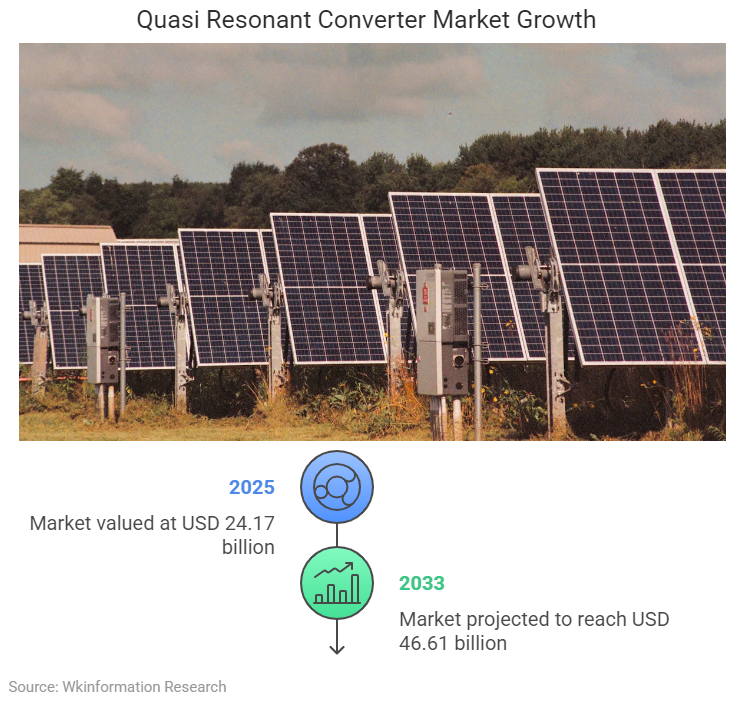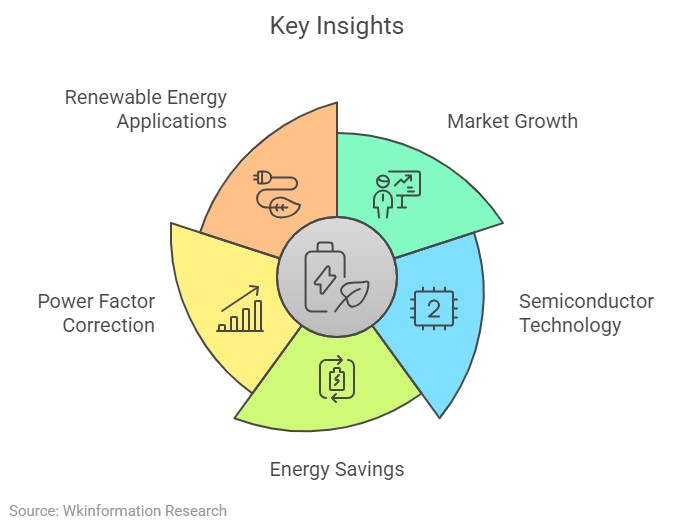
The quasi resonant converter market has witnessed remarkable growth, valued at USD 24.17 billion in 2025 and projected to reach USD 46.61 billion by 2033, with a CAGR of 8.56%. This surge stems from the rising demand for energy efficiency across industries like consumer electronics and automotive. Wide bandgap semiconductors, including gallium nitride (GaN) and silicon carbide (SiC), have revolutionized the sector. These materials enable converters to achieve higher switching frequencies and reduced losses, enhancing power density and performance. Advancements in semiconductor technology continue to drive innovation and adoption globally.
Key Insights
- The quasi-resonant converter market is growing fast. It may reach USD 46.61 billion by 2033 due to energy-saving needs.
- Special semiconductors like GaN and SiC make converters better. They allow faster switching and save more energy.
- These converters save energy by cutting switching losses. They are great for gadgets and electric cars.
- Adding power factor correction to these converters improves efficiency. It also lowers electromagnetic interference.
- These converters are important for renewable energy. They help manage and change energy effectively.

Overview of Quasi-Resonant Converter Technology

Principles of Quasi-Resonant Converters
Quasi-resonant converters operate by leveraging resonant switching to enhance power conversion efficiency. These converters minimize switching losses by achieving either zero-voltage or zero-current conditions during the switching process. This approach reduces energy dissipation, ensuring optimal performance. The operation involves generating a resonant pulse, which is then filtered through an output LC circuit. This design enables variable frequency operation, allowing the system to adapt to changing load conditions effectively. By integrating these principles, quasi-resonant converters achieve high efficiency in power transfer, making them a preferred choice in modern applications.
Key Advantages of Quasi-Resonant Converters
Improved Efficiency and Reduced Switching Losses
Quasi-resonant converters excel in reducing turn-on switching losses, a common issue in traditional power converters. By leveraging resonant circuits, they optimize power transfer and maintain high efficiency even under varying loads. This design also lowers device temperatures, enhancing the reliability and lifespan of the components. The use of resonant power converters ensures smoother operation, which is critical for applications requiring consistent performance. These features make quasi-resonant converters a cornerstone in achieving energy-efficient solutions across industries.
Lower Electromagnetic Interference (EMI)
The smooth waveforms generated by the resonant circuit significantly reduce high-frequency noise, which is a primary source of electromagnetic interference. This reduction in EMI ensures better compatibility with other electronic devices and minimizes disruptions in sensitive environments. The ability to maintain low noise levels while delivering high efficiency makes quasi-resonant converters an ideal choice for applications in consumer electronics, automotive systems, and industrial equipment. Their design not only enhances performance but also aligns with stringent regulatory standards for electromagnetic emissions.
Key Technological Trends
Advancements in Soft Switching Techniques
Zero Voltage Switching (ZVS)
Zero voltage switching (ZVS) represents a significant advancement in quasi-resonant type converters. This technique ensures that switching occurs when the voltage across the switching device is zero. By doing so, it minimizes energy losses and reduces stress on semiconductor components. ZVS enhances efficient voltage conversion by lowering turn-on losses, which is critical for improving overall system performance. This method also contributes to smoother operation, making it a preferred choice for applications requiring high reliability.
Zero Current Switching (ZCS)
Zero current switching (ZCS) is another key innovation in soft switching techniques. In this approach, the switching device operates when the current is zero, effectively reducing switching losses. Quasi-resonant type converters utilize ZCS by generating a resonant pulse through the FET, ensuring minimal energy dissipation. This advancement not only improves efficient voltage conversion but also extends the lifespan of the components by reducing thermal stress. ZCS plays a pivotal role in enhancing the reliability and efficiency of modern power conversion systems.
Integration with Power Factor Correction (PFC) Technology
The integration of quasi-resonant converters with power factor correction (PFC) technology has revolutionized power conversion systems. This combination reduces switching losses and enables high-frequency operations, resulting in enhanced efficiency. The active-clamp approach in advanced quasi-resonant type converters further improves performance by recycling transformer leakage energy and lowering electromagnetic interference (EMI). This integration also allows for a smaller circuit footprint, making it ideal for applications where space is a constraint. By combining PFC technology with quasi-resonant converters, manufacturers achieve efficient voltage conversion while meeting stringent regulatory standards.
Miniaturization and Higher Power Density
Miniaturization and higher power density have become essential trends in quasi-resonant type converters. These converters achieve compact designs by optimizing power transfer processes, which enhances efficiency and reduces switching losses. The smaller size of these systems makes them suitable for applications in consumer electronics and automotive sectors. Additionally, higher power density ensures that these converters deliver efficient voltage conversion without compromising performance. This trend aligns with the growing demand for lightweight and space-saving solutions in modern electronic devices.
Use of Wide Bandgap Semiconductors (e.g., GaN, SiC)
Wide bandgap (WBG) semiconductors, such as gallium nitride (GaN) and silicon carbide (SiC), have transformed the quasi-resonant converter market. These materials offer superior electrical properties compared to traditional silicon-based semiconductors, enabling higher efficiency and performance in power conversion systems.
Key Benefits of WBG Semiconductors in Quasi-Resonant Converters
- Higher Switching Frequencies
GaN and SiC devices operate at significantly higher switching frequencies. This capability reduces the size of passive components like inductors and capacitors, resulting in compact and lightweight designs. These features align with the growing demand for miniaturized power systems in consumer electronics and automotive applications. - Enhanced Thermal Performance
WBG semiconductors exhibit excellent thermal conductivity. This property allows them to handle higher power densities without overheating. As a result, quasi-resonant converters using GaN or SiC achieve greater reliability and durability, even in high-temperature environments. - Reduced Energy Losses
The lower on-resistance and faster switching speeds of WBG materials minimize conduction and switching losses. This improvement enhances overall system efficiency, making these semiconductors ideal for energy-efficient solutions in renewable energy and industrial sectors.
Note: The adoption of GaN and SiC technologies has enabled quasi-resonant converters to meet stringent energy efficiency standards, such as those set by the U.S. Department of Energy and the European Union.
Comparison of GaN and SiC Properties
| Property | Gallium Nitride (GaN) | Silicon Carbide (SiC) |
|---|---|---|
| Bandgap Energy | 3.4 eV | 3.26 eV |
| Thermal Conductivity | Moderate | High |
| Switching Speed | Very High | High |
| Cost | Lower | Higher |
Both GaN and SiC offer unique advantages. GaN excels in high-frequency applications, while SiC is better suited for high-power systems. Manufacturers often select the material based on specific application requirements.
Wide bandgap semiconductors continue to drive innovation in quasi-resonant converters. Their adoption is expected to grow as industries prioritize energy efficiency and performance optimization.
Market Analysis

Market Size and Growth Projections
The quasi resonant converter market has shown remarkable expansion in recent years. It was valued at $24.17 billion in 2025 and is projected to reach $46.61 billion by 2033, reflecting a compound annual growth rate (CAGR) of 8.56%. This market growth is driven by the increasing demand for energy-efficient and high-performance power conversion solutions. The adoption of quasi-resonant converters in electric vehicles and renewable energy systems further accelerates this trend. Additionally, the rising importance of minimizing energy losses in consumer electronics and industrial automation contributes significantly to the market’s upward trajectory.
Segmentation by Product Type
Zero-Current Switching Quasi-Resonant Converters
Zero-current switching (ZCS) quasi-resonant converters operate by ensuring that the switching device transitions when the current is zero. This approach minimizes energy losses and thermal stress, making it ideal for applications requiring high reliability. ZCS converters are widely used in power supplies and DC-DC conversion systems, where efficiency and durability are critical.
Zero-Voltage Switching Quasi-Resonant Converters
Zero-voltage switching (ZVS) quasi-resonant converters achieve switching when the voltage across the device is zero. This technique reduces switching losses and electromagnetic interference, enhancing overall system performance. ZVS converters are commonly employed in applications such as battery chargers and LED drivers, where smooth operation and energy efficiency are essential.
Segmentation by Application
Consumer Electronics
Consumer electronics represent the largest segment within the quasi resonant converter market. The demand for energy-efficient solutions in devices such as smartphones, laptops, and televisions drives this growth. The flyback converter market, a subset of this segment, plays a pivotal role in powering these devices efficiently.
Automotive
The automotive sector exhibits rapid growth due to the increasing adoption of electric and hybrid vehicles. Quasi-resonant converters ensure efficient power management in these vehicles, supporting their energy-saving objectives. The flyback converter market also contributes significantly to this sector by enabling compact and reliable power solutions.
Industrial Applications
Industrial applications, including automation and renewable energy systems, rely heavily on quasi-resonant converters for their energy efficiency. These converters optimize power usage in industrial equipment, reducing operational costs and environmental impact. The flyback converter market supports these applications by providing isolated power supplies for critical systems.
Geographic Distribution
North America
North America holds a significant share of the quasi-resonant converter market. The region benefits from advanced technological infrastructure and a strong focus on energy-efficient solutions. The United States leads in adopting quasi-resonant converters across industries such as automotive and consumer electronics. The growing demand for electric vehicles (EVs) further drives market growth. Companies in this region invest heavily in research and development to enhance converter performance. The flyback converter market also plays a crucial role in supporting the region’s demand for compact and efficient power solutions.
Europe
Europe demonstrates steady growth in the quasi-resonant converter market. The region’s stringent energy efficiency regulations encourage the adoption of advanced power conversion technologies. Countries like Germany and France lead in renewable energy initiatives, creating opportunities for quasi-resonant converters in solar and wind energy systems. The automotive sector, particularly electric and hybrid vehicles, contributes significantly to market expansion. The flyback converter market supports these applications by providing reliable and efficient power management solutions.
Asia-Pacific
The asia-pacific region dominates the quasi-resonant converter market due to rapid industrialization and urbanization. Countries like China, Japan, and South Korea drive demand through their robust consumer electronics and automotive industries. The region’s focus on renewable energy adoption further boosts market growth. The flyback converter market thrives in this region, addressing the need for compact and energy-efficient power supplies in various applications. The asia-pacific region’s competitive manufacturing landscape and government incentives for energy-efficient technologies strengthen its market position.
Rest of the World
The Rest of the World segment, including regions like Latin America, the Middle East, and Africa, shows emerging potential in the quasi-resonant converter market. Increasing investments in renewable energy projects and industrial automation drive demand. The flyback converter market supports these regions by enabling cost-effective and efficient power solutions. Although the market share remains smaller compared to other regions, ongoing infrastructure development and energy efficiency initiatives indicate promising growth opportunities.
Competitive Landscape
Major Players in the Market
Several key players dominate the quasi-resonant converter market, leveraging their expertise and resources to maintain a competitive edge. These companies focus on innovation, strategic partnerships, and customer-centric approaches to meet the growing demand for energy-efficient solutions.
- Infineon Technologies AG: Infineon leads the market with its advanced semiconductor solutions. The company invests heavily in research and development to enhance product performance and efficiency. Its focus on energy-efficient designs aligns with the increasing demand for sustainable power conversion systems.
- Texas Instruments Incorporated: Texas Instruments emphasizes product innovation and customer-focused solutions. The company offers a wide range of quasi-resonant converters tailored to diverse applications, including telecommunication infrastructure and automotive systems. Its robust distribution network ensures timely delivery and support.
- ON Semiconductor Corporation: ON Semiconductor prioritizes energy-efficient technologies and strategic collaborations. The company’s portfolio includes high-performance quasi-resonant converters designed for industrial and consumer electronics. Its investments in production capacity enable it to meet the rising demand effectively.
These companies also emphasize after-sales services and customized solutions to strengthen customer relationships and expand their market presence.
Emerging Companies and Startups
Emerging companies and startups are making significant strides in the quasi-resonant converter market. These firms focus on niche applications and innovative technologies to carve out their space in the competitive landscape. Many startups target telecommunication infrastructure, offering compact and efficient power solutions. Their agility allows them to adapt quickly to market trends and customer needs. By leveraging partnerships and collaborations, these companies gain access to advanced technologies and expand their reach.
Recent Mergers, Acquisitions, and Collaborations
Mergers, acquisitions, and strategic collaborations play a pivotal role in shaping the quasi-resonant converter market. Companies use these strategies to enhance their technological capabilities and market presence. For instance, leading players have partnered with telecommunication infrastructure providers to develop energy-efficient power solutions tailored to this sector. These collaborations enable stakeholders to address evolving market demands and regulatory requirements effectively. Additionally, acquisitions of smaller firms allow major players to integrate innovative technologies and expand their product portfolios. Such activities contribute to a dynamic and competitive market environment.
Challenges and Opportunities
Market Restraints
High Initial Costs
The quasi-resonant converter market faces significant challenges due to high development and implementation costs. Advanced design and manufacturing processes increase production expenses compared to traditional power conversion solutions. These elevated costs create barriers for new entrants and limit adoption in cost-sensitive markets.
Technical Complexity
The technical complexity of quasi-resonant converters poses another restraint. Manufacturers often struggle to optimize performance and reliability due to intricate designs. Potential users may also lack the expertise required to implement and maintain these systems effectively.
Key Impacts:
- High initial investment costs deter new players from entering the market.
- Technical challenges discourage adoption among users unfamiliar with advanced power conversion technologies.
Market Drivers
Growing Demand for Energy-Efficient Solutions
The demand for energy-efficient power supply solutions continues to fuel market growth. Consumer electronics, including smartphones and laptops, require efficient power conversion to meet performance expectations. Industrial applications prioritize energy efficiency and renewable energy integration, further driving adoption. The automotive sector, influenced by the rise of electric vehicles, demands efficient power management systems. Telecommunications also benefits from energy-efficient solutions to support high-speed data transmission and network expansion.
Increasing Adoption in Automotive and Industrial Sectors
The automotive and industrial sectors are key contributors to the market’s expansion. Electric vehicles rely on quasi-resonant converters for efficient power management, aligning with sustainability goals. Industrial automation systems benefit from these converters’ ability to optimize energy usage, reducing operational costs and environmental impact.
Future Growth Potential
Expansion in Renewable Energy Applications
The global shift toward renewable energy presents significant opportunities for quasi-resonant converters. Solar and wind power systems increasingly rely on these converters to manage and convert energy efficiently. Their role in enhancing system performance and reliability makes them indispensable in sustainable energy solutions.
Innovations in Semiconductor Materials
Innovations in semiconductor materials are expected to drive future growth. Wide bandgap materials like gallium nitride (GaN) and silicon carbide (SiC) enable higher switching frequencies, lower energy losses, and increased power density. These advancements enhance the efficiency and performance of power conversion systems, meeting the demands of growing electronic device production.
Tip: The adoption of GaN and SiC technologies positions quasi-resonant converters as a cornerstone in modern energy-efficient applications.
Overview
The quasi resonant converter market is set to experience robust growth, driven by advancements in wide bandgap semiconductors like GaN and SiC. These materials enhance efficiency and performance, making them indispensable for applications in electric vehicles and renewable energy systems. The integration of digital control technologies further boosts reliability and adaptability. Stakeholders can capitalize on this momentum by focusing on product innovation, expanding production capacities, and forming strategic partnerships. Emerging applications, such as battery management systems and solar power solutions, present significant opportunities for growth in this evolving market.
| Report Metric | Details |
|---|---|
| Report Name | Global Quasi Resonant Converter Market Report |
| Base Year | 2024 |
| Segment by Type |
· Zero-Current Switching Quasi-Resonant Converters · Zero-Voltage Switching Quasi-Resonant Converters |
| Segment by Application |
· Consumer Electronics · Automotive · Industrial Applications |
| Geographies Covered |
· North America (United States, Canada) · Europe (Germany, France, UK, Italy, Russia) · Asia-Pacific (China, Japan, South Korea, Taiwan) · Southeast Asia (India) · Latin America (Mexico, Brazil) |
| Forecast units | USD million in value |
| Report coverage | Revenue and volume forecast, company share, competitive landscape, growth factors and trends |
FAQ
What is a quasi-resonant converter?
A quasi-resonant converter is a type of power converter that uses resonant switching techniques to minimize energy losses. It achieves high efficiency by operating at zero-voltage or zero-current conditions during switching, making it ideal for energy-efficient applications.
How do quasi-resonant converters differ from traditional converters?
Quasi-resonant converters reduce switching losses by leveraging resonant circuits, unlike traditional converters. They operate at variable frequencies, adapting to load changes. This design enhances efficiency, reduces electromagnetic interference, and improves reliability, making them superior for modern applications.
What industries benefit most from quasi-resonant converters?
Industries such as consumer electronics, automotive, and renewable energy benefit significantly. These converters power devices like smartphones, electric vehicles, and solar systems efficiently, aligning with the growing demand for energy-saving solutions.
Why are wide bandgap semiconductors important in quasi-resonant converters?
Wide bandgap semiconductors, like GaN and SiC, enable higher switching frequencies and reduced energy losses. They enhance thermal performance and power density, making quasi-resonant converters more efficient and reliable for advanced applications.
What challenges do manufacturers face in adopting quasi-resonant converters?
Manufacturers encounter high initial costs and technical complexities. Designing and implementing these converters require advanced expertise and resources, which can limit adoption in cost-sensitive markets.
Global Quasi Resonant Converter Market Report (Can Read by Free sample) – Table of Contents
Chapter 1: Quasi Resonant Converter Market Analysis Overview
- Competitive Forces Analysis (Porter’s Five Forces)
- Strategic Growth Assessment (Ansoff Matrix)
- Industry Value Chain Insights
- Regional Trends and Key Market Drivers
- Quasi Resonant ConverterMarket Segmentation Overview
Chapter 2: Competitive Landscape
- Global Quasi Resonant Converterplayers and Regional Insights
- Key Players and Market Share Analysis
- Sales Trends of Leading Companies
- Year-on-Year Performance Insights
- Competitive Strategies and Market Positioning
- Key Differentiators and Strategic Moves
Chapter 3: Quasi Resonant Converter Market Segmentation Analysis
- Key Data and Visual Insights
- Trends, Growth Rates, and Drivers
- Segment Dynamics and Insights
- Detailed Market Analysis by Segment
Chapter 4: Regional Market Performance
- Consumer Trends by Region
- Historical Data and Growth Forecasts
- Regional Growth Factors
- Economic, Demographic, and Technological Impacts
- Challenges and Opportunities in Key Regions
- Regional Trends and Market Shifts
- Key Cities and High-Demand Areas
Chapter 5: Quasi Resonant Converter Emerging and Untapped Markets
- Growth Potential in Secondary Regions
- Trends, Challenges, and Opportunities
Chapter 6: Product and Application Segmentation
- Product Types and Innovation Trends
- Application-Based Market Insights
Chapter 7: Quasi Resonant Converter Consumer Insights
- Demographics and Buying Behaviors
- Target Audience Profiles
Chapter 8: Key Findings and Recommendations
- Summary ofQuasi Resonant Converter Market Insights
Actionable Recommendations for Stakeholders



